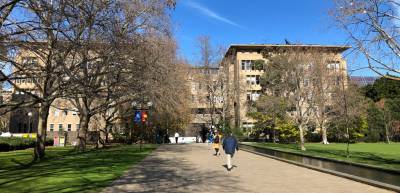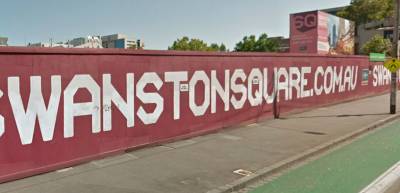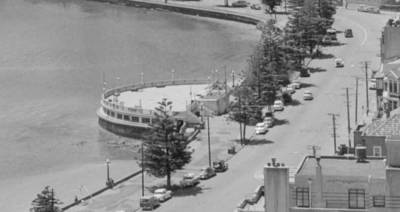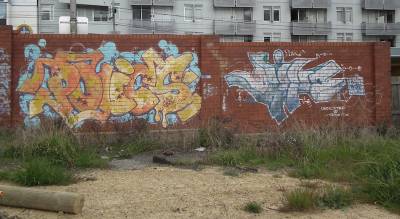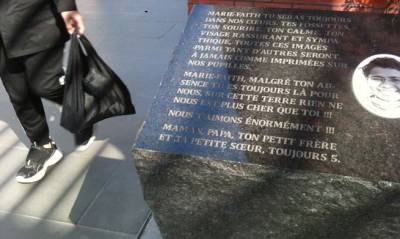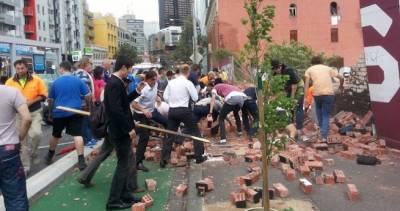home » news » authorities » Australia » Victoria
The wall, two years later

Kegs lined up against the wall, c. 1980s (VHD)
An old brick wall collapsed in central Melbourne two years ago, killing three young students walking past on a busy footpath. I cobbled together a history of the wall and published it. Then time passed. Occasional news articles focused on fragments of the official investigations, but it was (and is) hard to get the big picture on what has happened since March 2013. In summary: not a lot.
[ Previous posts: FIRST – March 2013 SECOND – April 2013 THIRD – April 2013 ]
I stopped at the site on the second anniversary last weekend and found dead flowers in the vases of the “temporary memorial”. It’s a slab of stone that appears to be frozen in the midst of falling off a rough concrete wall (which could be the original). It perhaps too closely recalls the events of the day. The main purpose of the slanted top seems to be to stop people from fixing things to it, which is unfortunate. In the week after the collapse, a melamine shrine was erected – simply a shelf that people could lave candles and notes on, and flowers and stubbie holders. It was probably more appropriate.

Temporary memorial, March 28, 2015 (PJ)

Original shrine, April 4, 2013 (PJ)
The only hint that it was the anniversary was a white wreath from the CFMEU union propped against a planter. The newspapers were silent, as they had nothing new to report.
I’ve dredged court reporting and pieced together a timeline of what has happened since March 28th, 2013. I did not know of the dates of the various hearings and did not attend. Audio recordings of hearings are available at a cost to “non-parties” with family permission for one year and they are then destroyed. I have not sought these out. The Melbourne public is totally reliant on coverage of the case by the media, which has been rather disjointed.
Several inquiries were meant to be underway in the immediate aftermath of the collapse. Grocon, WorkSafe (also called “WorkCover”), Victoria Police, the Building Commission (now VBA) and the Coroners Court were all conducting investigations. It is hard to find much trace of these. The Coroner’s website has no information on the wall collapse other than some name suppressions. WorkSafe’s websites have two articles, both published soon after the collapse. The VBA website has nothing about their investigation of the collapse.
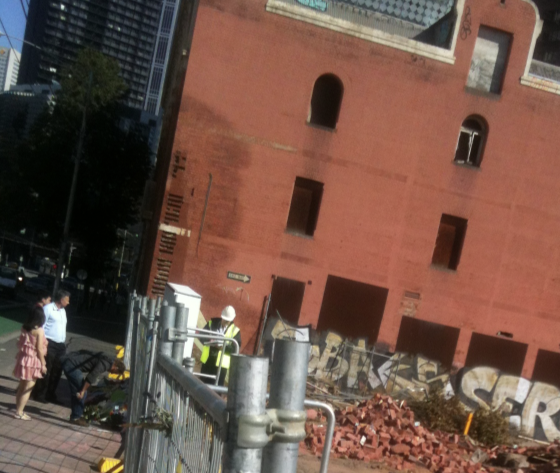
An inspector at the wall on April 4th, 2013
A chronology
March 28th, 2013
New information about 28/3/13 since my last reports
- the wall was constructed in 1971 with a building permit.
- Grocon hired Aussie Signs to build the wall in October 2011. They sublet the job to another contractor.
- the wall made a creaking sound just before it fell
- the hoarding peeled away
- others were injured but left the scene immediately
March 29th, 2013
Planning Minister Matthew Guy tells radio 3AW that he understands the wall was “more than a hundred years… The wall has been [left there since the CUB demolition] so I understand that’s the rationale for keeping it.”
Media around the country report that the wall was very old. Not much is done to correct this when two days later the wall is discovered to be quite new.
April 30th, 2013, WorkSafe
WorkSafe’s media website announces that an investigation is continuing but, “given the complexity of the task it remains in its relatively early stages and will take some time to complete.” “The investigation’s primary focus is to determine whether any offences under the Occupational Health and Safety Act 2004 have been committed.” VWA News
The authority also issues a safety alert on its website, which is a reworking of a 2004 alert.
May 24th, 2013, Coroners Court
Coroner Ian Gray warns that possible criminal prosecutions could stall the coronial inquest for several years. He does not rule out the possibility of holding the inquest in tandem with proceedings in other courts. ABC
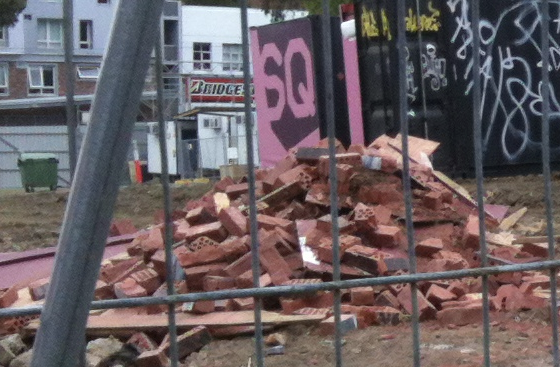
December 4th, 2013, Coroners Court direction hearing
A police investigator tells the Coroners Court that Grocon had failed to provide witness statements other than that of an archaeologist who had previously worked at the site. The state coroner judge said he would order 18 other Grocon-associated witnesses to give statements if they were not forthcoming within a fortnight. The investigators had managed to interview 60 other witnesses.
Police investigators also tell the court that they were unable to obtain an engineering survey about a bluestone wall from Grocon, as the commpany had said it was not relevant. The judge orders it to be made available anyway, by the end of the week.
While he is at it, Gray criticises WorkSafe for not having shared with police 10 folders of material from their own investigation. WorkSafe lawyers reply, saying this would not be possible before April 2014. Judge Gray: “This happened nine months ago. Of course there’s a lot involved… but I’m not prepared to accept I should wait as long as you’re proposing.”
Gray orders that a “critical” engineering report be delivered within two weeks, well before the coronial inquest which is set for June, 2014.
A “well-placed legal source” tells The Age that, “WorkSafe say they’re doing their best but Grocon are lawyered up and are being totally unco-operative.”
This tallies with what I’ve been told by another source who said that Grocon had more than 15 lawyers at the hearing, slowing proceedings. I also heard that few Melbourne building professionals were willing to provide expert advice to the authorities and so some experts were sought from afar.
The Age’s allegations were refuted in the Herald Sun in an article: published online that same day. Grocon and WorkSafe affirmed that Grocon had been cooperating, while the State Coroner refused to comment.
In the only reference to the wall collapse on the Coroner’s Court website, Coroner Gray makes an interim suppression order prohibiting publication of information which may identify four key witnesses. The order is to be reviewed on December 19th at another direction hearing. There is no further mention of the case or the name suppressions on the website.
Sources:
ABC
The Age 05.12.13
December 19th, 2013, Coroners Court direction hearing
14 Grocon employees have been interviewed since the judge ordered Grocon employees to give statements to the police. Three would not provide statements until “other processes in the investigation have occurred.” Their lawyers justified this on the grounds that they might incriminate themselves. These three, and a further witness who agreed to talk to the police, were granted name suppression.
2014
All remnants of the fallen wall have been removed, and the footpath has been resealed. In March Grocon install a temporary stone memorial and planter boxes, for which a planning permit was obtained.
March 28th, 2014, Swanston Square on the anniversary
Construction work halts for a day out of respect for Bridget Jones, Alexander Jones and Marie-Faith Fiawoo. A Grocon spokesman says, “The important questions about why these three young lives were lost are not yet resolved but some answers will no doubt emerge when the Coronial inquest begins later this year.”
April 29th, 2014, Magistrates’ Court
Worksafe (Victorian WorkCover Authority) files criminal charges at the Magistrates’ Court against three Grocon companies and Aussie Signs (the subcontractor who erected the sign). Each charge is eligible for a fine not exceeding $1.3M, however this is limited by the Magistrates’ Court limit of $305,000.
The Herald Sun was able to view VWA’s charge sheet, which stated that, “The attachment of the hoarding to the wall was unsafe… It was reasonably practicable for Grocon Pty Limited to have eliminated or reduced the risk to the health and safety of persons in the vicinity of the wall and hoarding.”
Referring to the lack of engineering and wind design, inspections and building permits, the documents allege that, “Grocon did not take any of the above measures to eliminate or reduce the risk to health and safety of persons who were not its employees. Nor did it ensure that any other person or entity took such measures.”
A third party, Paramount Signs, erected the wall for Aussie Signs. The 29 year old owner of Paramount is facing $72,000 in fines for not having a building permit. He is the first person to be charged in the case.
The Aussie Signs quote was approved on October 6th, 2011, with work beginning on October 10th and finishing four days later.
Grocon executive chairman Daniel Grollo says, “Grocon’s priority remains to assist investigating authorities as they continue to closely examine all of the factors that contributed to the wall collapse and identify what needs to be done to see it never happens again.”
The coronial inquest, scheduled for June 2014, is delayed indefinitely.
Sources:
ABC
“Building giant Grocon and sign firm hit with seven criminal charges over fatal Swanston St wall collapse” Herald Sun 29.04.14
“Contractor faces criminal charges…” Herald Sun 29.04.14

Early October – the hoarding is erected and painted (Fairfax video)

Early October – the hoarding is extended to the Malt Store. This extension looks almost like an afterthought but would place additional pressure on the end of the brick wall, to which it was bolted. (Fairfax video)
May, 2014, VBA
The Victorian Building Authority reissues its “When is a building permit required?” fact sheet, adding two new clauses relating to signs on free-standing walls. Here’s one:
“A building permit is required for signs that are attached to free standing walls, permanent or temporary fences that put addition dead and live (wind) loads and forces on the wall or fence that hasn’t been designed for those additional loads. To prevent the possibility of the collapse of the wall or fence, the wall or fence will need to be assessed for structural soundness and be structurally certified to ensure it can withstand the additional forces imposed by the sign.”
The previous edition, in 2008, required a building permit for a new sign above one metre, but made no mention of signs attached to existing structures.
June 25th, 2014, Magistrates’ Court
A subcontractor to the signage subcontractor appeared at the Magistrates’ Court. He had been charged by the Victorian Building Authority with constructing a timber structure attached to a wall without a permit. Unlike those previously charged, his full name, age and address were published.
July, 2014
Grocon puts two northern sites at C.U.B. on the market, totalling 6,600 square metres.
August 25th, 2014, Magistrates’ Court
Magistrate Charlie Rozencwajg allows Grocon lawyers six weeks to vet 600 WorkSafe (WorkCover) documents.
September 26th, 2014, Swanston Street
The 29 year old signage sub-subcontractor charged by the VBA in June reappears at the Magistrates’ Court. His lawyer tells the court that his client received a letter from Aussie Signs making it clear that no work permit was required. He says that their defence team is trying to access information from the coroner’s investigations in order to shed more light on the details of this sub-subcontractor agreement.
September 30th, 2014, Swanston Street
In high winds, a temporary gangway roof on the Swanston Square building site blows off its fixings, flips and lands upside down on the footpath at the scene of last year’s tragedy. Pedestrians ran for it. ABC – with photos
October 6th, 2014, Magistrates’ Court
The court learns that mounds of earth from an archaeological dig were seen immediately next to the wall prior to its collapse. A Grocon VS lawyer asks if he can question the archaeologists about the extent of their operation. “We’re not talking about the pyramids of Giza”, says the lawyer. The magistrate grants the request.
The committal hearing is expected to take 12 days and to involve more than 40 witnesses.
The lawyers for Aussie Signs would like to establish whose idea it was to hang the hoarding on the wall, while the three Grocon entities want to know who commissioned the work.

The mounds of earth in late February, 2013 – credit Glenn Wilson
November 12th-13th, 2014, Magistrates’ Court
At the first day of the committal hearing, Grocon (Victoria Street) Pty Ltd and the prosecutors come to an agreement. Grocon would plead guilty immediately if the matter would stay in the Magistrates’ Court, and if they could plead on a risk basis, rather than a causal one (meaning that they did not cause the wall to collapse). If GVS were to plead guilty to one of two charges, the four charges against two other Grocon subsidiaries whould be dropped, pending court approval. The prosecution no longer believed it could be proven beyond reasonable doubt that mounting the hoarding on the wall caused it to fall.
Lawyers for Aussie Signs did not become aware of this conditional plea until the week before. Their QC Nick Papas said, “it changes things completely.”
Three Grocon companies had each been charged with two identical offences. 1. “[failing to ensure] persons other than your employees were not exposed to risks to their health and safety arising from the conduct of your undertaking” and 2: failing to ensure a workplace was safe and without risks to health. GVS would plead guilty only to the second charge, which relates to employee safety, not the safety of passersby.
WorkCover’s allegations centre on the lack of a building permit, the lack of a bracing design, the lack of a wind risk assessment, and the lack of a post-construction engineer’s inspection.
QC Ray asserts that, “it’s not possible to say that the conduct of the accused caused the wall to collapse… Whilst it’s serious offending, the measure of disregard is not at the highest end.”
“He said rather, [Grocon VS] should have been aware of [the wall’s] capacity to withstand wind, and should have conducted an assessment of the wall’s capacity. He said it was reasonable to accept Grocon would have taken action to reduce that risk.” ABC
By pleading guilty at the Magistrates’ Court, rather than have the case proceed to the County Court, the maximum fine would be $305,350. The maximum fine at the County Court is $1.1M.

Aerial view from North, c. 2011, Bing Maps
Magistrate Charlie Rosencwaig says previous demolition works left the wall unshielded and vulnerable to wind. He refers to an expert witness who would testify that the wall would have fallen within five to ten years without the hoarding. “With the hoarding, it comes down to six to twelve months.” He questions whether the case was resolved with Grocon’s guilty plea. But he also thinks the fine “ample” for the offence, and notes that, “closure and finalisation is a very important aspect in matters such as this.”
Grocon chairman Daniel Grocon writes in a press release that, “this process has identified areas in which we, and the industry as a whole, can improve our procedures to ensure the safety of the public, and our employees, is further protected, including on vacant sites.”
Several witnesses in the immediate aftermath of the collapse state that they saw rusted or corroded brick ties within the debris. An MFB inspector stated that, “there was no attachment from one skin to another.”
A City of Melbourne building surveyor defends the council’s inaction after the hoarding was erected. They saw no need to take action.“From our perspective this fence or wall had a building permit and has been in use and has been standing up since 1971… It’s only when issues are brought to our attention as to safety that we investigate and try to determine what needs to be done, if anything.”
An inspector from WorkCover visited the wall during the installation of the hoarding and saw nothing inappropriate or dangerous.
Aussie Signs decides not to match Grocon’s guilty plea. Under instruction from the Director of Public Prosecutions, the prosecution requests that the Aussie Signs case be send to trial at the Supreme Court. Magistrate Charlie Rosencwaig questions this, asking why they hadn’t requested the same for Grocon. The prosecutor replied that the case was sufficiently important to go to the Supreme Court.
A builder subcontracted by Aussie Signs, and who is being prosecuted by the Victorian Building Authority, is to appear as a witness.
Sources: ABC | ABC | “WorkCover drops claim Grocon caused deadly wall collapse” The Australian 12.11.14 | “Grocon to plead guilty…” The Age 12.11.14 | “Ties on Melbourne collapse wall had rusted through, court told” The Australian 13.11.14 | Herald Sun 14.11.14 | “Grocon’s maximum fine after wall collapse a ‘slap on the wrist’” The Age 13.11.14 | “Grocon guilty…” Sourceable 13.11.14 | Architecture and Design 14.11.14

enlarged detail of 1979 aerial view of wall. Credit: Wolfgang Sievers, NLA
November 20th, 2014, Magistrates’ Court
At the second day of the hearing, Grocon pleads guilty to one breach of the Occupational Health & Safety Act. Regarding WorkSafe’s allegations, Grocon Victoria Street’s QC Ross Ray says that the company was entitled to a presumption of integrity due to the “free-standing” wall’s 1971 building permit. “When it’s built with a permit there’s no need to go back and recertify”, said QC Ray. The lack of risk assessment was due to the site not being considered a building site at that stage. GVS relied upon its subcontractor Aussie Signs to assess risk.
Grocon’s lawyers express “deep regret”, and seek a fine of around $250,000. QC Ray said, “no one – no one – questioned the integrity of that wall. All people in the industry have learnt due to this tragic incident.”
Prosecutor Gregory Lyon said that Grocon had failed to check that Aussie Signs had ensured that the wall was safe before erecting the hoarding. This had exposed large numbers of pedestrians to the risk of injury or death. Ray replied that this risk hadn’t been picked up as the site wasn’t a construction site – Grocon had relied on their subcontractor – “that reliance was not enough”.
Grocon VS is fined $250,000 and costs on one charge, as Grocon had suggested. The maximum penalty at the Magistrates’ Court is $305,000.
According to Magistrate Rozencwajg, the incident represented a significant failure of the company’s duty, but acknowledged Grocon had since acted in the manner expected of a good corporate citizen.
Grocon executive chairman Daniel Grollo says, “in whatever small way, we hope that the timely conclusion of the proceedings today assists the families and friends affected by this tragedy.”
The committal hearing had been intended to run for 12 days. If there were further sittings they were not covered by the media. The news of the Grocon prosecution was not reported by WorkSafe’s own dedicated news website.
Sources: ABC | The Age | “Court hears Grocon wall had permit” SKY 20.11.14 | ABC
Saturday March 28th, 2015, Swanston Square on the 2nd anniversary
The hoarding along the site has been partially removed to make way for the entrance to the Swanston Square apartment building.
The AFR reported during the week Grocon would be selling off various portions of the C.U.B. site to other developers, but that they would retain the Swanston Street frontage. The Maltstore was sold earlier in the month to a Singaporean syndicate.
The Aussie Signs trial
This trial is to take place at the County Court, which uses juries. This is perhaps one reason for the lack of commentary on the wall in the past months. I cannot find mention of the trial in any court lists.
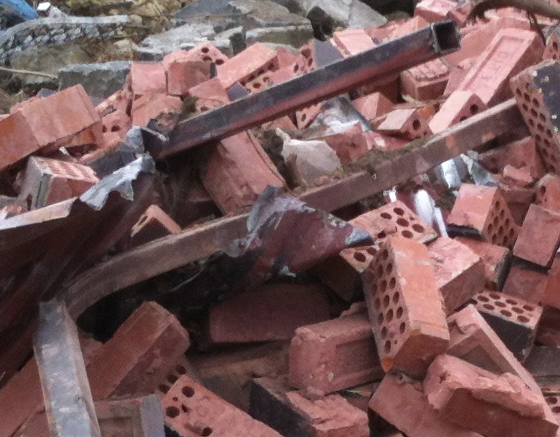
Where’s the mortar?
A few unanswered questions
Though these questions may have been discussed in the various hearings, no commentary or conclusions have been published (that I have been able to find).
- when was the 1971 building permit unearthed? Was there an inspection during construction in 1971?
- what reasons were given for Grocon (Victoria Street) Pty Ltd’s willingness to plead guilty to one charge (relating to employee risk), but not the other one (relating to public risk)?
- has any action been taken by the Planning Minister over the lack of a planning permit for the hoarding advertising?
- what are the details of the 1984 incident when the truck hit the wall? Rumour has it that the truck hit a different part of the wall, or possibly even another wall.
- what are the results of testing done on salvaged fragments of the wall?
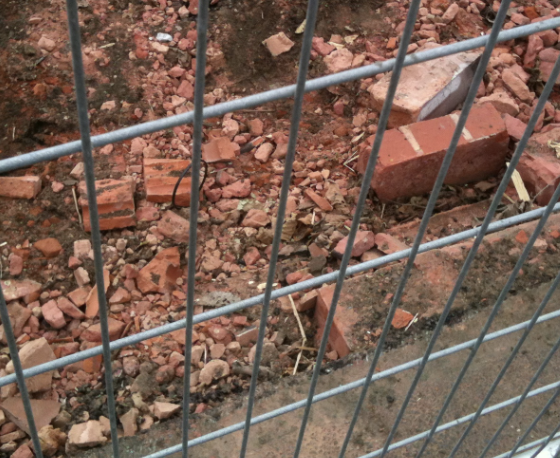
Street edge, with adjacent shallow concrete wall removed
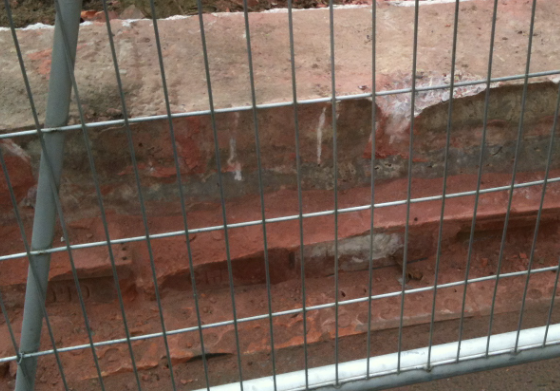
Bricks on end in hidden leaf. This is another indication that the concrete wall may have pre-dated the brick wall. PJ 2013
Some of the problems with the wall when it was built:
- it was over-height by about 700mm
- it had no effective buttressing or lateral restraint
- the pilasters sat on an adjacent concrete bund wall
- there was a combined concrete / brick system near the base of the wall. While brinks expand, concrete shrinks over time.
- there weren’t enough reinforcing ties. Boral recommends medium duty metal ties spaced at no more than 400mm horizontally and vertically.
- the wall had a stretcher bond – no headers (cross-laid bricks) other than the top capping
- there was no drip edge on the capping bricks (though this is not uncommon in Victoria)
- there was inconsistent mortaring – both flush and raked used – both of which were unsuitable
- there were no control joints to allow for movement
- there was an apparent lack of mortar in the vertical (collar) joint between leaves
- perforated capping bricks were left open to weather at wall step downs.
- at least 5 types and ages of bricks were used, including old pressed bricks and newer extruded bricks. There would have been varying porosities, compression strengths. The old and new bricks may have required different mortar mixes.
- there was either a lack of mortar, or else the mortar had not adherred – noticeable in post-demolition photos showing clean bricks
- a steel end support at the north end of the wall, and other steel fixings for a gate, may have caused eccentricities in the wall due to the differing rates of expansion
- there was no noticeable DPC beneath the capping
- the hidden leaf of bricks, between the concrete wall and the facing bricks, in some places contained rubble and in others bricks were used on end.
“It appears to contravene every rule in the book” Trevor Huggard. Former Lord Mayor, engineer in The Age 03.04.13
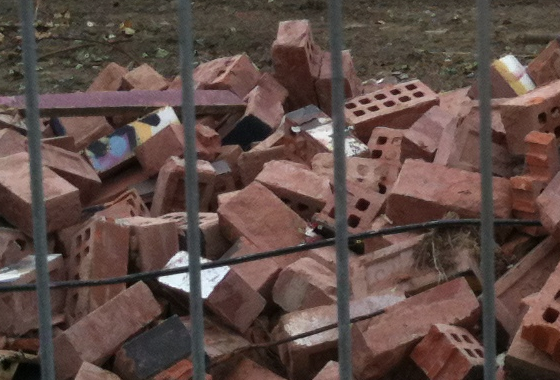
Some of the problems for the wall after it was built:
- the southern abutting building was demolished in 1989
- the brewery was demolished by Hudson Conway, exposing the wall to wind and gusts across the site
- the few wall ties seen after collapse were corroded.
- capping bricks fell off and were not replaced
- the mortar had deteriorated in many places
- efflorescence was visible on the face of the wall at mortar joints
- there was evidence of mould colonies within the wall
- the outer face was sealed with paint
- most of the inner face was sealed with graffiti
- the addition of a plywood hoarding in late 2011
- storage of earth adjacent to the wall in February 2013
( Information from news, photos, court hearings, brick construction manuals, head )
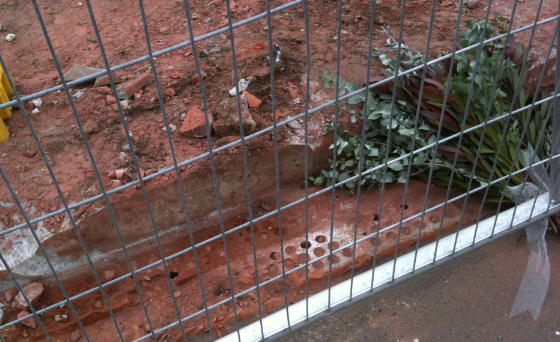
Preventing a repeat
Walls have continued to fall around Victoria since 2013 and will continue to do so. These accidents attract little attention unless there is an injury or death. If the wall in Swanston Street had fallen at 4a.m. when no one was around, its likely we’d not even remember it had happened.
I had expected there to be more of a discussion about the safety of neglected sites and construction sites, but instead the media and courts have focused on the hoarding. Perhaps some initiatives are in train, but after two years of waiting, I’m not hopeful.
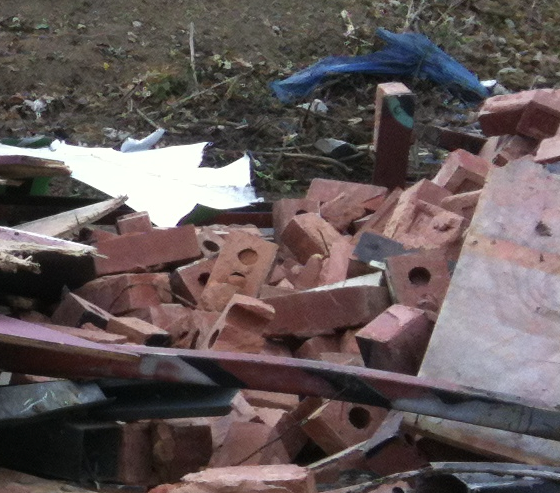 _Yet another type of brick: 3 hole extruded_
_Yet another type of brick: 3 hole extruded_
What could be done?
This isn’t meant to be a comprehensive list. That would require a building industry-wide response. But there hasn’t been one.
- Rate holidays on vacant sites could cease – RMIT didn’t pay rates on the CUB site for eight years because it is an educational institution.
- Rates and land tax on land-banked sites and “bomb sites” could be reviewed.
- Demolition sites could be redefined as construction sites, and so be subject to the same safety requirements.
- Archaeological digs immediately prior to building, and requiring bulk earth moving, could be considered part of the early construction process.
- Site dilapidation reports should be the norm when large properties change hands. ( sample PDF )
- Selling sites like Monopoly could be discouraged.
- There could be a public safety hotline, with a phone number prominent on any hoarding around bomb sites.
- There could be an advanced weather forecasting system (AWFS) sending out automated alerts, as is now happening in Calgary.
- WorkSafe could extend its remit beyond employees to the general public, better reflecting the stated objectives of the OH&S Act.
- Worksafe could publish its construction incident report on its website, as it has done previously.
- The Ministry for Planning and the City of Melbourne could sort out their demarcation issues on site boundaries. They could also assure the public about what they have done to lessen the possibility of a recurrence.
- Salient points contained in the hundreds of Australian Standards for construction could be made free so that smaller builders and contractors are encouraged to obtain them and refer to them. Minimum expected standards should not be locked behind a pay-wall, especially those that affect public safety.
- Encourage use of the building code (now National Construction Code) by making it free, as New Zealand did some years ago after the “leaky building” scandal revealed widespread ignorance in the industry. This is being acted upon now by the ABCB – the 2015 online edition will be free to view.
- A permanent memorial could be built for the three students. One not tucked in a corner.
Calgary
As mentioned in my first post, toddler Michelle Krsek was killedin 2009 by 250kg of flying roofing iron near a construction site. This prompted a conversation about public safety in Calgary which has led to several actions. These include the formation of the On-Site Construction Safety Committee ( a joint initiative between the city, the construction association and the OH&S authority ), a best practices guide commemorating Kersk ( PDF ), an advanced weather forecasting alert system, a public safety component in construction degrees, a construction award and scholarship in Michelle’s name, and a push for changes to legislation to better include third parties (the general public). It’s not perfect but at least the wheels are turning. Canadian OH&S consultant Peter M. Knaack sums up the state of things there – but he could equally be describing Victoria.
“While employers, supervisors, regular employees and contractors represent the most important identified stakeholders within Canada’s collective body of safety statutes and regulations, other significant stakeholders also exist whose importance presently remains only poorly defined and regulated under existing Canadian occupational health and safety legislation. Although largely ignored by the health and safety statutes and regulations, victims of industrial accidents who are not actual parties to the work being conducted represent the most significant additional risk factor to any public or private employer.”
Posted by Peter on 05.04.15 in authorities
tags: brick, demolition, developers, safety, swanston street wall, wind
comment
The southern end of the hoarding was a plywood fence. The wind loads deflected by the containers stored on site would have applied pressure to this section of the hoarding which was also bolted to the masonry wall acted as a sail applying rotation force. The wooden panel The Structure of the hording at this point was such that it firmly fixed to the masonry wall. There was no fail joint. The concentrated wind load and rotation forced acted like a lever and began to pull the wall over. The weight of the wall escalating and peeling the masonry wall off its foundations. The masonry wall was stable but not designed to withstand this horizontal force. Formerly the wall would have been braced by the roof structure that the wall supported. It was the applied rotation force on the plywood section of the wall caused the collapse.
Thanks so much for this detailed account. I will share with Master of Architecture students next semester for all the structural and legal reasons of why this matters to anyone in the ‘trade’. Thanks. S
by Sophie Giles on 12 December 2016 ·#
What happened to the inquest into this tragedy? Has it happened and where can I read the findings?
by Serena Whittington on 5 February 2018 ·#
I passed the memorial yesterday on my way to the University which caused me to search for what happened. What a senseless loss of life.
Common sense and a simple ‘no we are not doing this’ at any point would have saved 3 lives. This is somehow overlooked in favour of legal arguments.
by Michael Smith on 15 February 2018 ·#
Do we know when the coroner will progress their investigation?
by Aspen on 7 March 2018 ·#
Commenting is closed for this article.
